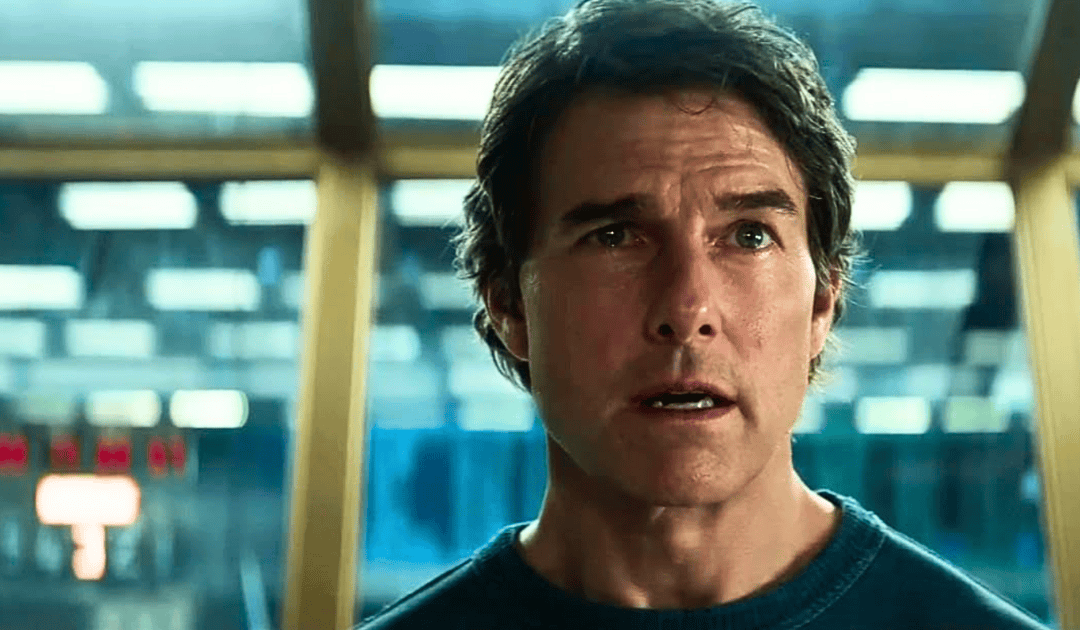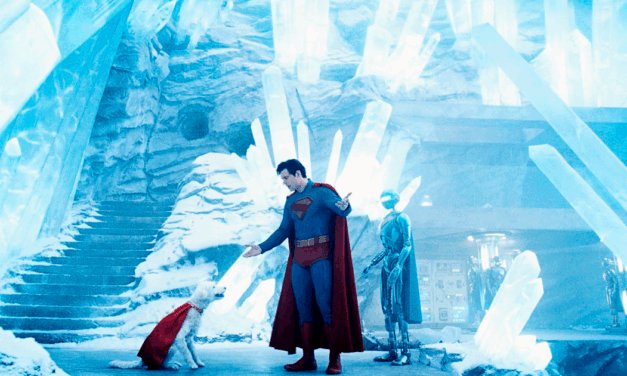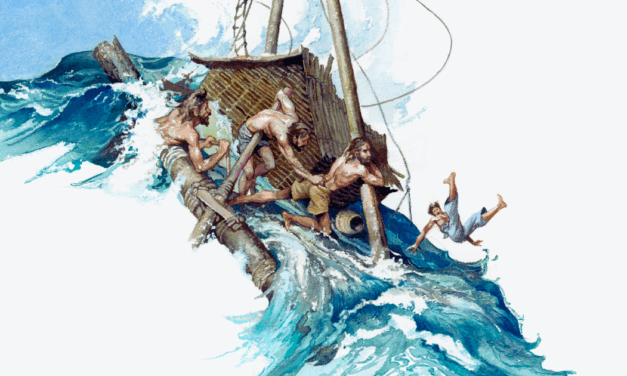Listen to this article (21:14 min)
The following article appeared as an online-exclusive in CHRISTIAN RESEARCH JOURNAL, volume 48, number 02 (2025).
When you support the Journal, you join the team and help provide the resources at equip.org that minister to people worldwide. These resources include our ever-growing database of more than 2,500 articles and Bible Answers, as well as our free Postmodern Realities podcast.
Another way you can support our online articles is by leaving us a tip. A tip is just a small amount, like $3, $5, or $10, which is the cost of a latte, lunch out, or coffee drink. To leave a tip, click here.
[Editor’s Note: This review contains spoilers for Mission Impossible — The Final Reckoning.]
Mission: Impossible — The Final Reckoning
Directed by Christopher McQuarrie
Written by Christopher McQuarrie and Erik Jendresen, based on the television series created by Bruce Geller
Producers: Tom Cruise, Christopher McQuarrie
Paramount Pictures, 2025
PG–13
In late 2020, COVID-19 restrictions were still locking down much of the world. Folks were working from makeshift offices at home. Many kids were still attending school on Zoom. And Hollywood had two problems on its mind. Theater attendance was low. The highest-grossing film of 2020 was Bad Boys for Life, with only 206 million domestically. All the big Summer releases had to be put on hold. Perhaps even more distressingly, for an industry that employs a small army of creatives who work in close proximity, social distancing posed a nearly insurmountable challenge. Film productions had also ground to a halt.
But not Mission: Impossible — Dead Reckoning Part One.1 The seventh installment of the franchise was slated to start filming in the Spring of 2020 in Italy, which was the site of the second major outbreak and a cautionary example. Quarantined in their Italian hotels, the production team didn’t take a day off and worked to get the movie back on its feet as soon as possible. Filming began again in the Summer in Norway, Italy, and England, a testament to the persuasive power of the movie’s actor-producer. Like any of the schemes of the Impossible Mission Force, the production did not go smoothly. A fire destroyed a stunt rig in England. An outbreak shut down filming in Italy for a few weeks. But the movie sprinted on with a determined stride.
COVID Protocol. However, one COVID-related incident is more famous than all the others. The challenge of making this film in 2020 became truly apparent to the world in a bit of leaked audio from December of that year. Tom Cruise, the series star and producer, explodes at his crew in a London stage set. The reason? A few of the crew members were huddled too close together, looking at a computer, violating protocols.
The audio of the rant is lengthy, punctuated with vulgarity for effect, and delivered with the passionate intensity that made the A Few Good Men2 actor a household name worldwide. Sometimes on-set tirades are merely fodder for juicy gossip, but Cruise’s illuminates the challenges of the production, and the leadership role he had assumed for himself in recent years.
We are the gold standard. They’re back there in Hollywood making movies right now because of us! Because they believe in us and what we’re doing! I’m on the phone with every ******* studio at night. Insurance companies! Producers! And they’re looking at us and using us to make their movies….No apologies. You can tell it to the people that are losing their ******* homes because our industry is shut down. It’s not gonna put food on their table or pay for their college education. That’s what I sleep with every night. The future of this ******* industry! So, I’m sorry, but I am beyond your apologies. I have told you and now I want it, and if you don’t do it, you’re out!3
Cruise’s sometimes strange behavior has alienated him from the general public. His Scientology.4 The seemingly forced couch jumping. The manic, relentless enthusiasm. But I found this tirade endearing. It made me like Cruise more. It exhibits the frustration and passion of a driven artist with a lot on his mind. A consummate professional who elicits praise from his collaborators, it is the opposite of a petulant outburst. This is the stern warning of a leader who is trying to pull off an extremely difficult task, an impossible mission, who needs his team to rise to the challenge.
A discussion of the production challenges of Mission: Impossible 7 is helpful because it keeps the film’s animating creative and thematic force, Tom Cruise, in focus. The Mission: Impossible series was the first major production by Cruise. A reboot of an old TV series, Mission: Impossible (1966–1973; 1988–1990), the films lifted a few of the key elements (masks, heists, espionage, and the iconic theme), largely jettisoned the rest, and dropped in major action set-pieces.
Mission: Impossible’s Legacy. The first film, Mission: Impossible (1996), established the modus operandi for the first half of the series. Cruise would recruit a director with a distinct style that would infuse the film with a unique feel. Brian DePalma brought his twisty, paranoid obsessions to the table, and Cruise brought his established best-at-everything iconography. To make the break from the TV show clear, one of the lead characters of the IMF from the original series, Jim Phelps, was revealed to be a villain. The movie ends with Cruise’s Ethan Hunt as IMF’s true hero.
The first Mission: Impossible also introduced an element that would come to define the series: Cruise-as-stuntman. Taking on the final train vs. helicopter battle himself, Cruise ran take after take where he was propelled onto the back of a moving train from an exploding helicopter. Always a dramatic (or slightly comedic) actor, the world discovered 15 years after his first role that Cruise was also an action star.5
Subsequent films would bring in John Woo for balletic action, J. J. Abrams for relational drama, and Brad Bird for kinetic dynamism. It was only after the fourth film that Cruise found his cinematic soulmate, Christopher McQuarrie, who blended the elements and incidents of the earlier films into something like a unified style.
McQuarrie’s flexibility suited Cruise’s continual demand to revise and refine each film until he was satisfied.6 The general pattern for a Mission movie is establishing spectacular stunts that Cruise himself would perform. These stunts take months, or sometimes years, to perfect (such as the HALO jump in Fallout [2018]). Plot elements, such as the movement of the MacGuffin from place to place, are rewritten or reshot to string the story together.
Again, all this may seem like prolonged throat-clearing about the business of making movies before getting to the themes that should be of interest to readers of a journal about ideas. But this is not the case. The main thing that the Mission: Impossible movies are about is movies. Specifically, these movies. The series is self-reflexive. The Mission movies are about a highly competent team with a knack for stagecraft and audacious feats led by a highly driven professional with a seemingly impossible goal. Throughout the series, Ethan/Tom comes up with a crazy idea. The question is raised: how will they possibly do this? And the answer is given: We’ll figure it out. One has to assume this is the mantra behind the camera as well. Ghost Protocol (2011) opens with the team breaking Ethan out of prison, but rather than escaping right way, Ethan demands to be let further into the prison to rescue a friend. An already difficult task becomes even more challenging. The exasperated Benji reluctantly agrees to this, and one feels that this dynamic mirrors the production, as Cruise and his collaborators refuse to settle for the easy option.
The main reason to see a Mission: Impossible film is to marvel at the handful of stunts that the filmmakers have made very clear were really performed by the lead actor. Cruise has established himself, late in life, as a stunt actor on par with Jackie Chan or Buster Keaton. Whether he is hanging on to a jumbo jet at takeoff or hanging off the side of the world’s tallest building, the camera’s crisp focus on Cruise’s face shows us that no CGI was used to stick his head on a stuntman. Perhaps a safety wire was painted out, but the actor really did this. And not just once. For the HALO jump in Fallout, Cruise and his skydiving cameraman ran the jump over 200 times. With this in mind, one can understand his frustration at some English crew members who can’t remember to stand six feet apart.
The Worldview of Mission: Impossible. To be fair to the films, there are themes. A few ideas rattle through the Mission films, becoming clearer as the series progresses. In what follows, I will attempt a somewhat complete list of the big ideas worth considering:
- The mission cannot be denied: As with the James Bond films, the threats Ethan and company face are so world-endangering that they must be accepted. As such, the films exist within a world of moral clarity that paves a straight path for heroism. Deadly plagues, nuclear war, or extinction at the digital hands of AI disentangle the audience from the murkier questions of world politics. Though double-crosses and twists might confuse the heroes and the audience, once the masks are pulled off, all motivations fall neatly into black and white. As with other spy franchises that have endured into the 21st century, the Mission series does not simply assume that Western world powers are always in the right. But Ethan always is.
- The mission does not require compromise if you trust the right person: Connected to this theme — but existing in tension with it — is the idea that moral compromise for the sake of some greater good is loser-talk. Ethan, improbably and against all odds, finds a way to defuse threats and destroy the villain without dirtying his hands. Throughout the series, Ethan’s team learns to trust him to accomplish what no one else can. In Rogue Nation (2015), Alec Baldwin’s character calls Ethan “the living manifestation of destiny.”7 The final film’s trailer features Ethan speaking to the president as he attempts to save the world: “I need you to trust me one last time.”8 This line, delivered nearly straight to the camera, might as well be a pledge to the audience. Though Cruise is 62. Though moviegoing is in peril. Though we think we’ve seen it all — Cruise can still pull it off one last time.
- The mission is all-consuming: Simply put, Ethan Hunt has “Spider-Man problems.” This is to say that his great responsibilities come at a relational cost. Though the film dabbles with romantic entanglements, climaxing in the third film, where Ethan Hunt gets married, it becomes very clear that his is a lonely path. His only lasting relationships are work relationships. As we hear a number of times in the films, including the last, Ethan and his team “live and die in the shadows. For those we hold close, and for those we never meet.”9 One is tempted, of course, to see this drive in Ethan reflected in the actor-producer who possesses a drive nearly unparalleled in Hollywood. Working nonstop. In top shape at 62. Spending hours taking pictures with fans at film openings all around the world. Despite his rocky personal life, Cruise is highly dedicated to his collaborators, learning even the names of minor crew members. But he’s also obsessed with pleasing the audiences he will never meet.
- The mission relies on humans, not technology: Beginning with the fourth film, this tech-heavy series introduces a minor theme about technology-gone-haywire. In Brad Bird’s Ghost Protocol, nothing works correctly. The mask-maker breaks, the gloves go on the fritz, and even the message that is supposed to destroy itself in five seconds glitches. The result requires quick thinking and stern resolve from the heroes to pull it off. Suspicion about technology is raised to a fever pitch in Dead Reckoning and The Final Reckoning, where AI (currently a looming threat to Hollywood artists) attempts to take over the world. The ultimate stunt scene takes place on old-fashioned biplanes, because only analog technology can be trusted. For a film series that has resisted the use of CGI to manufacture action scenes, this final villain hardly seems accidental. Throughout the last film, Ethan fights servants of the AI “Entity” IRL. In a particularly funny line, after knocking one of the Entity’s henchmen into unconsciousness, he quips, “You’re spending too much time on the internet.”10
Notably absent from the above list of themes are, of course, many of the weightier issues of human life. Religion is nearly absent from the films. The first movie name-drops the book of Job. In Mission: Impossible III (2006), Ethan infiltrates the Vatican. And in The Final Reckoning, a dying Luther tells Ethan, “I will see you again, though I hope it’s not too soon.”11 Aside from these brief glimpses of a larger spiritual world, the series exists in continuity with Hollywood’s default secularity. Future historians would have a difficult time discerning that most humans in the 21st century worshiped some God by studying our most popular entertainment. Based on the demographic numbers, at least one in four of the American characters in Mission: Impossible should be out-of-office on Sunday morning.
Though the Mission movies star an iconic actor, there’s little that’s iconic about the movies themselves besides the incredible set-pieces that gleam like diamonds attached to a string of yarn. The plots are workmanlike or even muddy. The dialog mostly exposits the location of the MacGuffin or establishes the current threat level. Countries and political strife exist solely to provide locations and stakes, as in a game of Risk.
Likewise, human interactions seem artificial or sentimental. Though the crew gathers periodically for beers and shares a laugh, we have a hard time imagining what their personal lives might look like. The most revelatory relational scene in the series takes place in Mission: Impossible III, at Ethan’s engagement party to a civilian doctor. We watch as Ethan gladhands the guests while also fielding a call from his IMF handler. The scene shows Ethan/Tom acting like a normal human, but it is clear that he is acting. Strangely, Ethan/Tom is much more believable when he is performing death-defying stunts.
To prepare for this article, I streamed the entire series with my adolescent kids. Watching the movies through my kids’ eyes confirmed my instincts. My son would repeatedly say, “Tom Cruise really did that,” after many of the big scenes. Sitting in the theater this weekend, my children barely stirred. The underwater submarine scene is so intense and well-crafted that it causes an almost unpleasant amount of tension. The IMAX-filmed biplane duel joins the Burj Khalifa and HALO jump on the Mount Rushmore of Mission stunts.
Unlike other spy franchises that conjure a vision for the good life of guns and gals and gin (like James Bond) or wrestle with realpolitik guilt (like Jason Bourne), there’s something refreshing about a film series that is nearly sexless, relatively clean, and is so unburdened by larger concerns that provides a purely cinematic experience. The movies have little to say, but lots to show. If there’s a fantasy to be enjoyed, it is the myth of Ethan’s superheroic competence. But as the behind-the-scenes making-of clips demonstrate, there’s some truth behind the myth.
What Should Christians Think? Well, one should certainly find Cruise’s work ethic inspiring. With a lot of hard work, passion, professionalism, and even the occasional scolding, one can pull off some incredible things. This is a lesson no Christian should despise. The book of Proverbs says as much: “The lazy do not roast any game, but the diligent feed on the riches of the hunt” (12:27 NIV, emphasis added). There’s also the superstar’s workmanlike dedication to his fans and seriousness about treating his collaborators well. Ethan/Tom is always dedicated to his team. And you can’t pull off a mission without a team.
If Saint Paul were speaking outside a movie theater, much like he did on Mars Hill, the lesson he might draw from our own poets is our deep longing for a hero who is both good and powerful (cf. Acts 17:28). In this, Mission: Impossible sits safely on a shelf with other tales of noble heroes who never compromise their ethics but still manage to right the wrongs of the world.
The tension between power and morality seems to be felt more strongly than ever in our stories. The heroes in contemporary iconography retain their powers but lose some of their principles. In the late 19th and early 20th centuries, Conan Doyle’s Holmes was eccentric, but ethical. Modern retellings, like the BBC’s Sherlock (2010–2017), seem to feel the need to take him down a few pegs to make him more believable. The DC Extended Universe felt the need to drag Batman and Superman down a bit closer to our level. Antiheroes, rather than heroes, are the order of the day. Even James Bond, never a true exemplar of ethics, but at least an idealized male fantasy, has not emerged unscathed from our more skeptical revisionism.
But not Ethan Hunt. He’s more like Captain America. An undiluted, elemental force that refuses to settle. He won’t trade lives. He doesn’t opt for the lesser of two evils. He puts himself at risk for the sake of the world and emerges, fantastically, victorious. This, more than any other passing references to religion in the film series, strikes me as the deeper meaning that resonates within it. Though Ethan is hardly a serious Christ-figure, he certainly puts himself into the jaws of death time and time again to save the world. With Ethan, as with God, all things are possible.
The historical, biblical Christian message, of course, elevates the nature of our salvation into the spiritual and pushes ultimate physical deliverance into the future. The improbable salvations of Mission: Impossible are focused on the here and now and largely just restore the status quo. But the eucatastrophies (sudden good turns) of their happy endings (as Tolkien said of fairy tales) still echo the Christian’s ultimate hope. They serve as fictional reminders to keep sprinting toward the ultimate reckoning (Hebrews 12:1–2).
Phil Tallon is an Associate Professor of Theology at Houston Christian University. He’s on Instagram: @oldhundreth.
NOTES
- Mission: Impossible — Dead Reckoning Part One, directed by Christopher McQuarrie, written by Christopher McQuarrie and Erik Jendresen, based on the television series created by Bruce Geller (Paramount Pictures, 2023).
- A Few Good Men (1992).
- “Tom Cruise Warns Mission Impossible Crew They’re ‘******* Gone’ If They Break Covid Rules on Set,” The Sun, December 15, 2020, YouTube, video, 2:48, https://youtu.be/tHteO55JzD4?si=E15DtYS_NEkx3FGk.
- Editor’s Note: For helpful articles on Scientology, see Hank Hanegraaff, “What Is Scientology? (T-E-A-R-S),” Christian Research Institute, July 31, 2023, https://www.equip.org/bible_answers/what-is-scientology-cbab/; John Weldon, “Scientology: From Science Fiction to Space-Age Religion,” Christian Research Journal, Summer 1993, https://www.equip.org/articles/scientology/.
- There may be no less descriptive and more deceptive last name than Cruise. Cruise is the one thing the actor has never done. Both on and off the screen, Cruise always sprints. Editor’s Note: Cruise’s screen debut was an uncredited appearance in Endless Love (1981), followed by his first credited role in Taps (1981). “Tom Cruise Biography, Filmography,” Fox News, updated January 13, 2015, https://www.foxnews.com/story/tom-cruise-biography-filmography.
- This make-it-up-as-we-go-along style to the series does not just apply movie to movie. Within each production there is constant rewriting and reshooting until Cruise is happy with the final product. The results are sometimes uneven. While this might diminish the enjoyment of the casual viewer, for those invested in the craft of movie-making itself, the visible seams and behind-the-scenes stories are fascinating.
- Mission: Impossible – Rogue Nation, directed by Christopher McQuarrie, written by Christopher McQuarie and Drew Pearce, based on the television series created by Bruce Geller (Paramount Pictures, 2015).
- Mission: Impossible — The Final Reckoning, directed by Christopher McQuarrie, written by Christopher McQuarrie and Erik Jendresen, based on the television series created by Bruce Geller (Paramount Pictures, 2025).
- Mission: Impossible — Dead Reckoning Part One.
- Mission: Impossible — The Final Reckoning.
- Mission: Impossible — The Final Reckoning.









